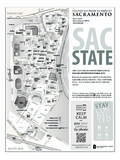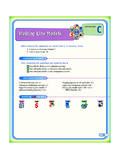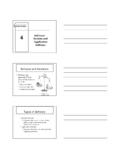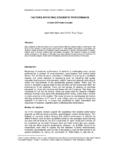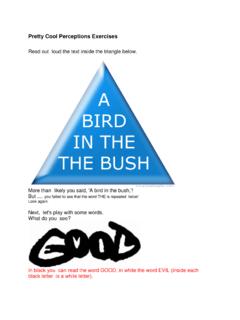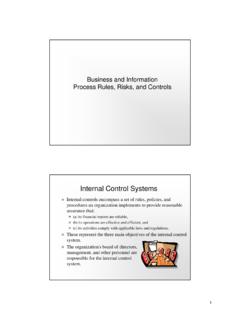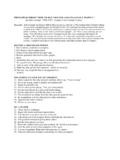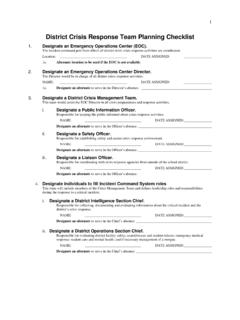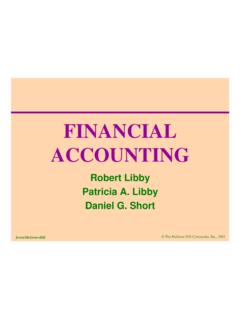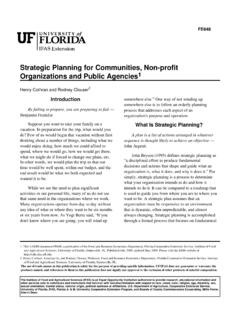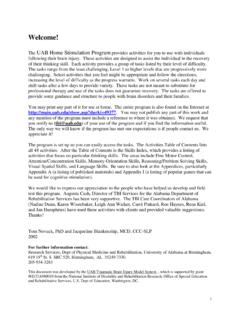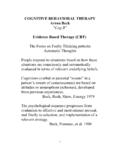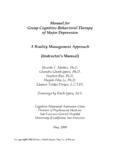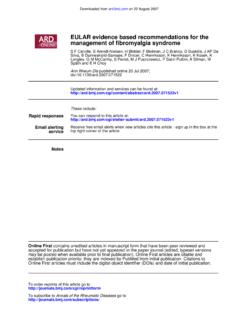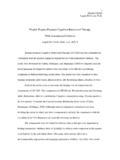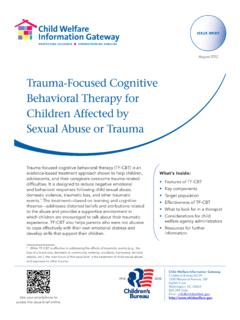Transcription of Schema Theory - csus.edu
1 Schema TheoryLinguists, cognitive psychologists, and psycholinguists have usedthe concept of Schema (plural: schemata) to understand theinteraction of key factors affecting the comprehension process. Simply put, Schema Theory states that all knowledge is organizedinto units. Within these units of knowledge, or schemata, isstored information. A Schema , then, is a generalized description or a conceptualsystem for understanding knowledge-how knowledge is representedand how it is to this Theory , schemata represent knowledgeabout concepts: objects and the relationships they havewith other objects, situations, events, sequences ofevents, actions, and sequences of actions. A simple example is to think of your Schema for dog. Within that Schema you most likely have knowledge aboutdogs in general (bark, four legs, teeth, hair, tails)and probably information about specific dogs, such ascollies (long hair, large, Lassie) or springer spaniels(English, docked tails, liver and white or black andwhite, Millie).
2 You may also think of dogs within thegreater context of animals and other living things;that is, dogs breathe, need food, and reproduce. Yourknowledge of dogs might also include the fact that theyare mammals and thus are warm-blooded and bear theiryoung as opposed to laying eggs. Depending upon yourpersonal experience, the knowledge of a dog as a pet(domesticated and loyal) or as an animal to fear(likely to bite or attack) may be a part of yourschema. And so it goes with the development of aschema. Each new experience incorporates moreinformation into one's does all this have to do with reading comprehension? Individuals have schemata for everything. Long beforestudents come to school, they develop schemata (units ofknowledge) about everything they experience.
3 Schematabecome theories about reality. These theories not onlyaffect the way information is interpreted, thus affectingcomprehension, but also continue to change as newinformation is received. As stated by Rumelhart (1980),schemata can represent knowledge at all levels-from ideologiesand cultural truths to knowledge about the meaning of aparticular word, to knowledge about what patterns of excitationsare associated with what letters of the alphabet. We haveschemata to represent all levels of our experience, at all levelsof abstraction. Finally, our schemata are our knowledge. All ofour generic knowledge is embedded in schemata. (p. 41)The importance of Schema Theory to reading comprehension alsolies in how the reader uses schemata. This issue has not yetbeen resolved by research, although investigators agree thatsome mechanism activates just those schemata most relevant tothe reader's task.
4 Reading Comprehension as cognitive - based ProcessingThere are several models based on cognitive processing (seeRuddell, Ruddell, & Singer, 1994, p. 813). For example, theLaBerge-Samuels Model of Automatic Information Processing(Samuels, 1994) emphasizes internal aspects of attentionas crucial to comprehension. Samuels(1994, pp. 818-819) defines three characteristicsof internal attention. The first, alertness, is thereader's active attempt to access relevant schematainvolving letter-sound relationships, syntactic knowledge,and word meanings. Selectivity, the second characteristic,refers to the reader's ability to attend selectively toonly that information requiring processing. The third characteristic, limited capacity, refers to thefact that our human brain has a limited amount of cognitiveenergy available for use in processing information.
5 Inother words, if a reader's cognitive energy is focused ondecoding and attention cannot be directed at integrating,relating, and combining the meanings of the words decoded,then comprehension will suffer. "Automaticity ininformation processing, then, simply means that informationis processed with little attention" (Samuels, 1994, ). Comprehension difficulties occur when the readercannot rapidly and automatically access the concepts andknowledge stored in the other example of a cognitive - based model is Rumelhart's(1994) Interactive Model. Information from severalknowledge sources (schemata for letter-sound relationships,word meanings, syntactic relationships, event sequences,and so forth) are considered simultaneously.
6 Theimplication is that when information from one source, suchas word recognition, is deficient, the reader will rely oninformation from another source, for example, contextualclues or previous experience. Stanovich (1980) terms the latter kind of processinginteractive-compensatory because the reader (any reader)compensates for deficiencies in one or more of theknowledge sources by using information from remainingknowledge sources. Those sources that are more concernedwith concepts and semantic relationships are termed higher-level stimuli; sources dealing with the print itself, thatis phonics, sight words, and other word-attack skills, aretermed lower level stimuli. The interactive-compensatory model implies that the readerwill rely on higher-level processes when lower-levelprocesses are inadequate, and vice versa.
7 Stanovich (1980)extensively reviews research demonstrating suchcompensation in both good and poor Comprehension as Sociocognitive ProcessingA sociocognitive processing model takes a constructivistview of reading comprehension; that is, the reader, thetext, the teacher, and the classroom community are allinvolved in the construction of meaning. Ruddell andRuddell (1994, p. 813) state, "The role of the classroom'ssocial context and the influence of the teacher on thereader's meaning negotiation and construction are centralto this model [developed by R. B. Ruddell and N. J. Unrau]as it explores the notion that participants in literacyevents form and reform meanings in a hermeneutic[interpretation] circle." In other words, this model views comprehension as a processthat involves meaning negotiation among text, readers,teachers, and other members of the classroom for text meanings, academic tasks, sources ofauthority ( , residing within the text, the reader, theteacher, the classroom community, or some interaction ofthese), and sociocultural settings are all brought to thenegotiation task.
8 The teacher's role is one oforchestration of the instructional setting, and beingknowledgeable about teaching/learning strategies and aboutthe Comprehension as TransactionalThe transactional model takes into account the dynamic nature of language andboth aesthetic and cognitive aspects of reading. According to Rosenblatt (1994,p. 1063), "Every reading act is an event, or a transaction involving a particularreader and a particular pattern of signs, a text, and occurring at a particulartime in a particular context. Instead of two fixed entities acting on oneanother, the reader and the text are two aspects of a total dynamic 'meaning' does not reside ready-made 'in' the text or 'in' the reader buthappens or comes into being during the transaction between reader and text.
9 "Thus, text without a reader is merely a set of marks capable of being interpretedas written language. However, when a reader transacts with the text, are not viewed as static but rather as active, developing, and everchanging. As readers transact with text they are changed or transformed, asis the text. Similarly, "the same text takes on different meanings intransactions with different readers or even with the same reader in differentcontexts or times" (Rosenblatt, 1994, p. 1078).Reading Comprehension as Transactional-SociopsycholinguisticBuild ing on Rosenblatt's transactional model, Goodman (1994)conceptualizes literacy processing as including reading, writing, andwritten texts. He states,Texts are constructed by authors to be comprehended by readers.
10 Themeaning is in the author and the reader. The text has a potentialto evoke meaning but has no meaning in itself; meaning is not acharacteristic of texts. This does not mean the characteristics ofthe text are unimportant or that either writer or reader are indepen-dent of them. How well the writer constructs the text and how wellthe reader reconstructs it and constructs meaning will influencecomprehension. But meaning does not pass between writer and is represented by a writer in a text and constructed from a textby a reader. Characteristics of writer, text, and reader will allinfluence the resultant meaning. (p. 1103)In a transactional-sociopsycholinguistic view, the reader has ahighly active role. It is the individual transactions between areader and the text characteristics that result in meaning.
